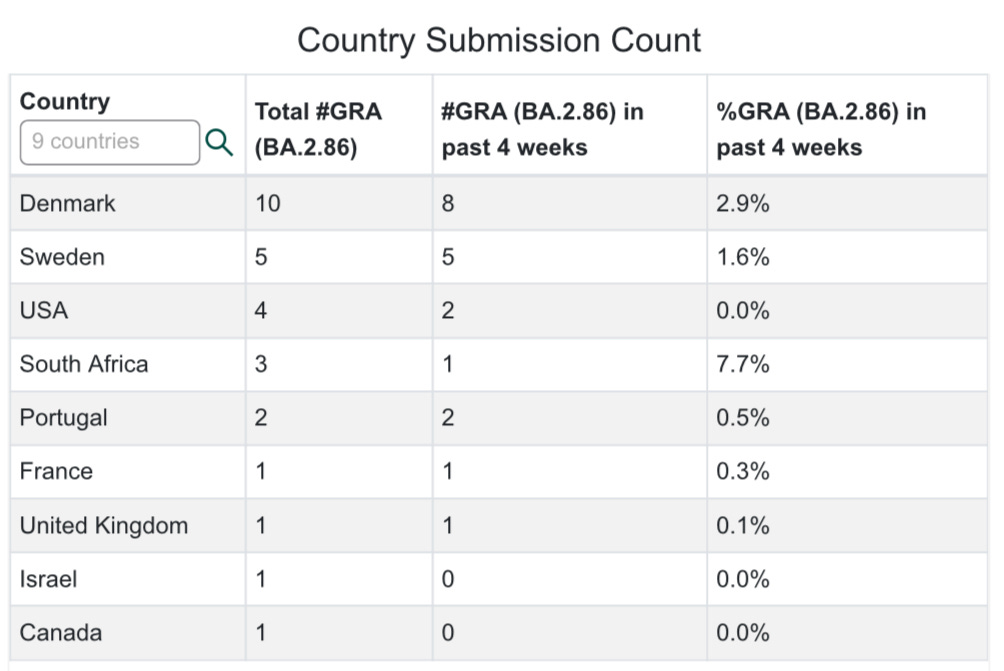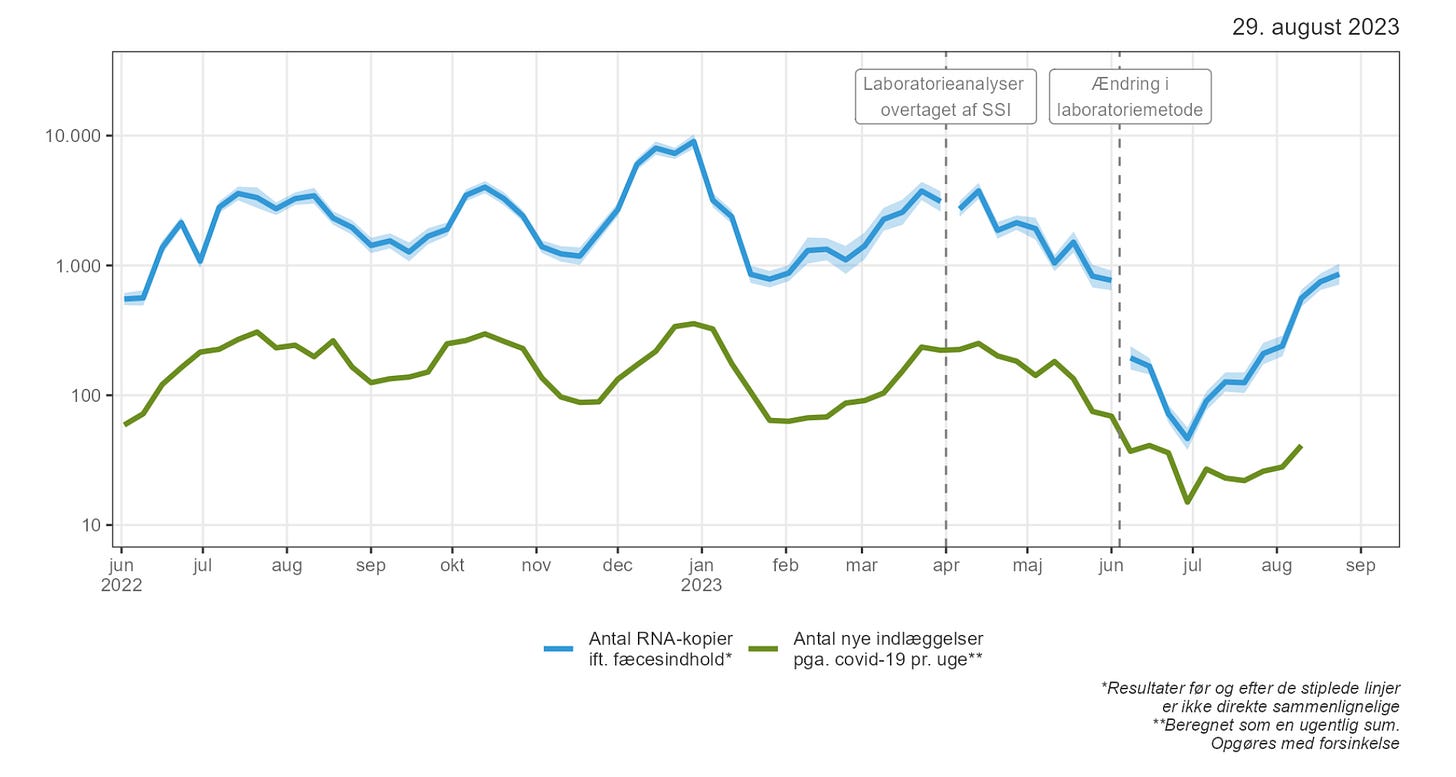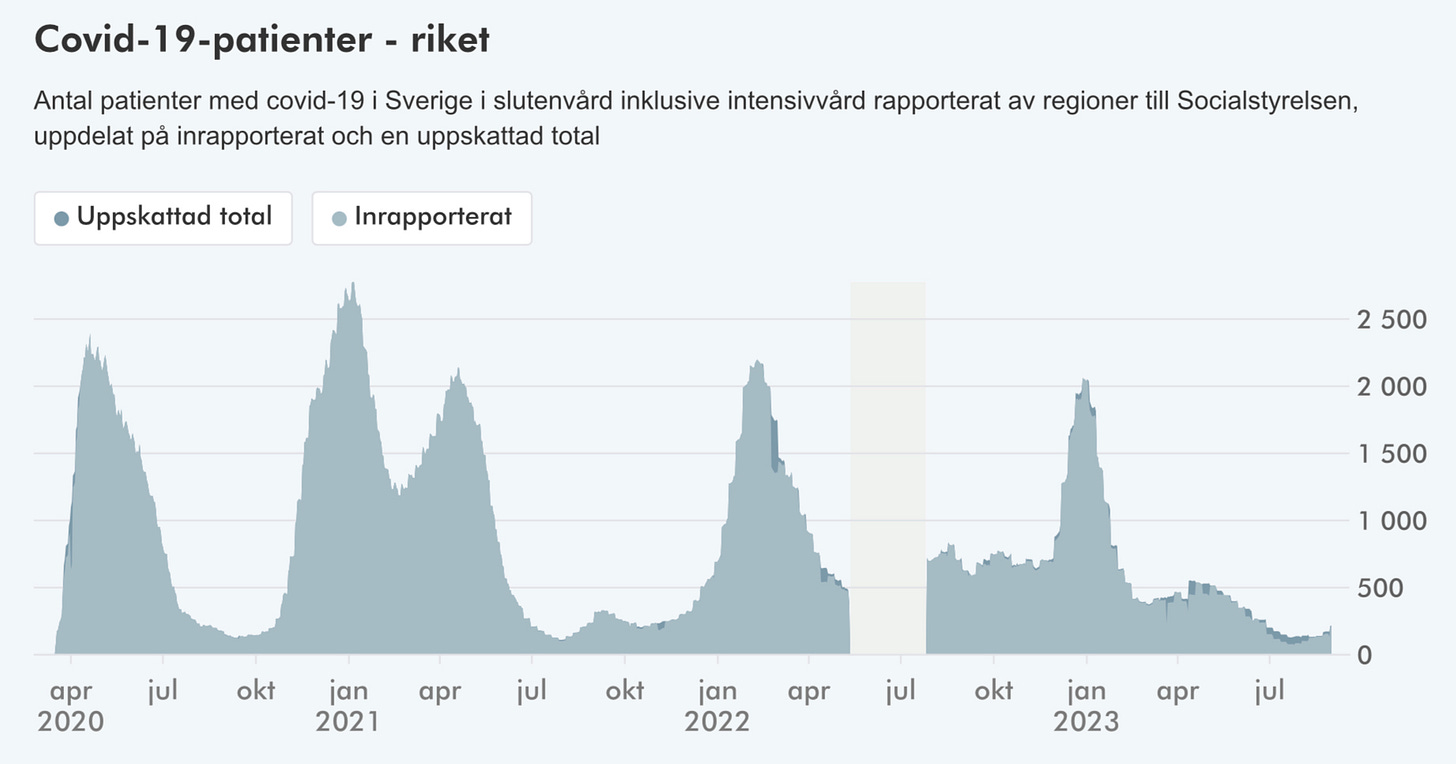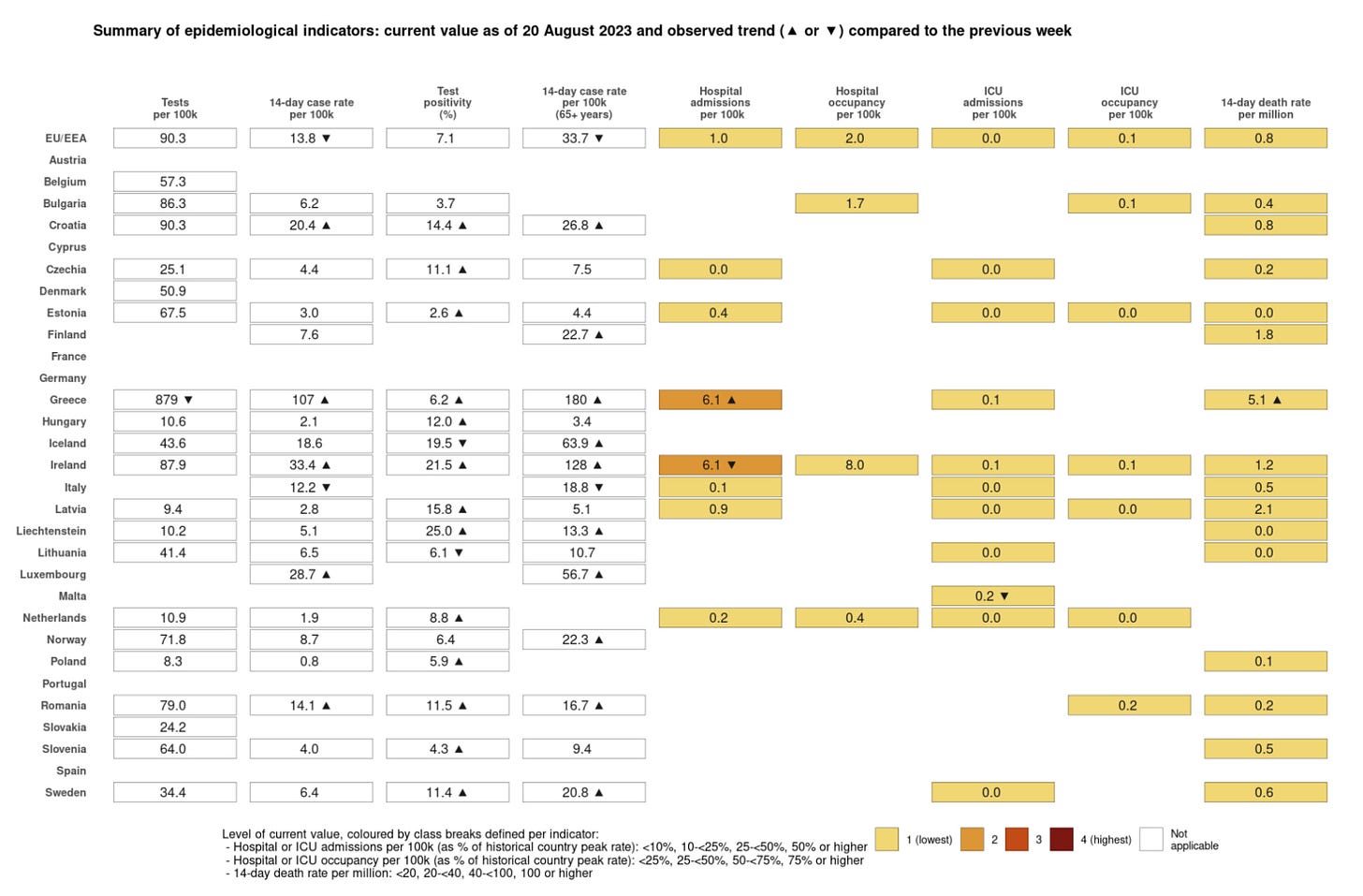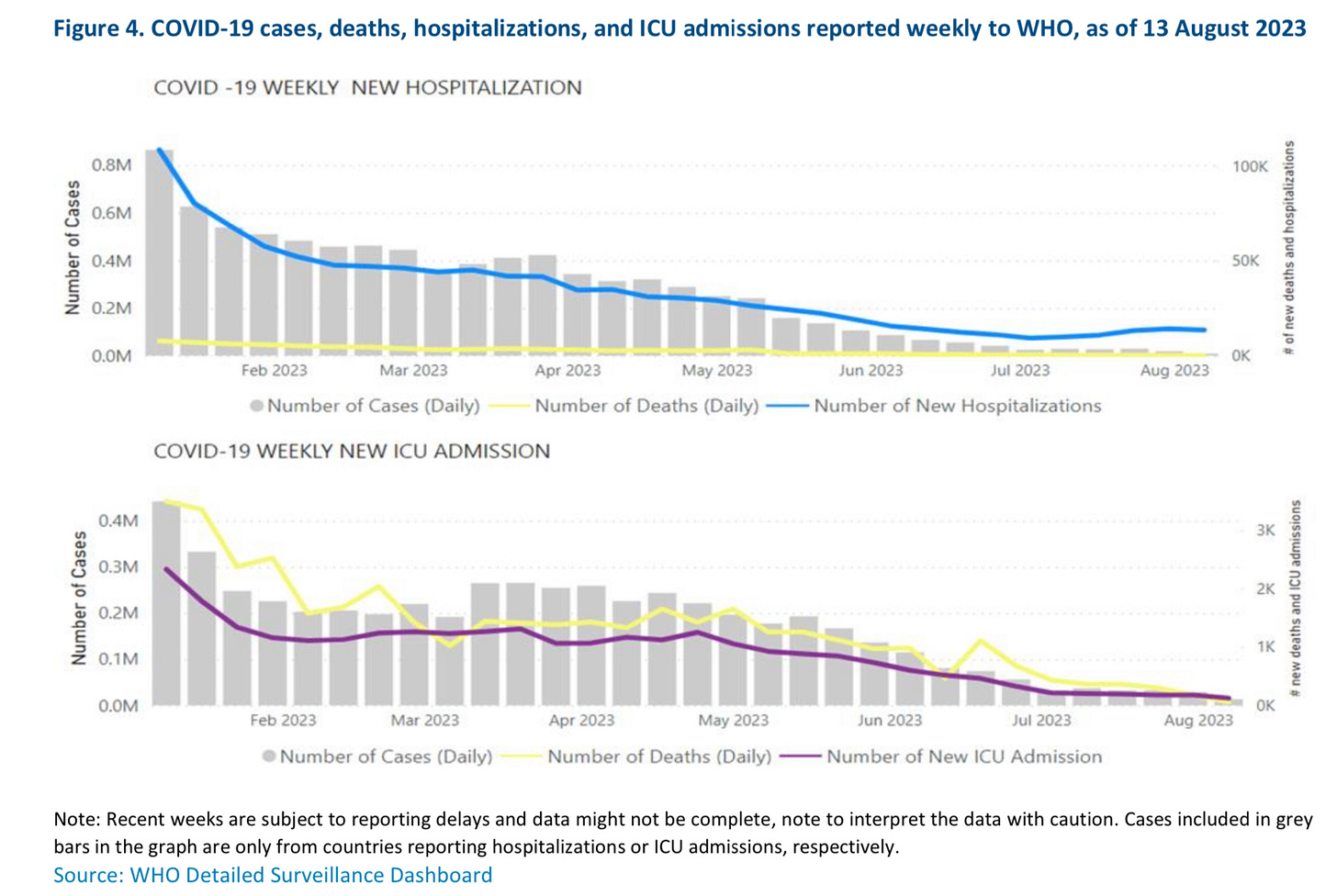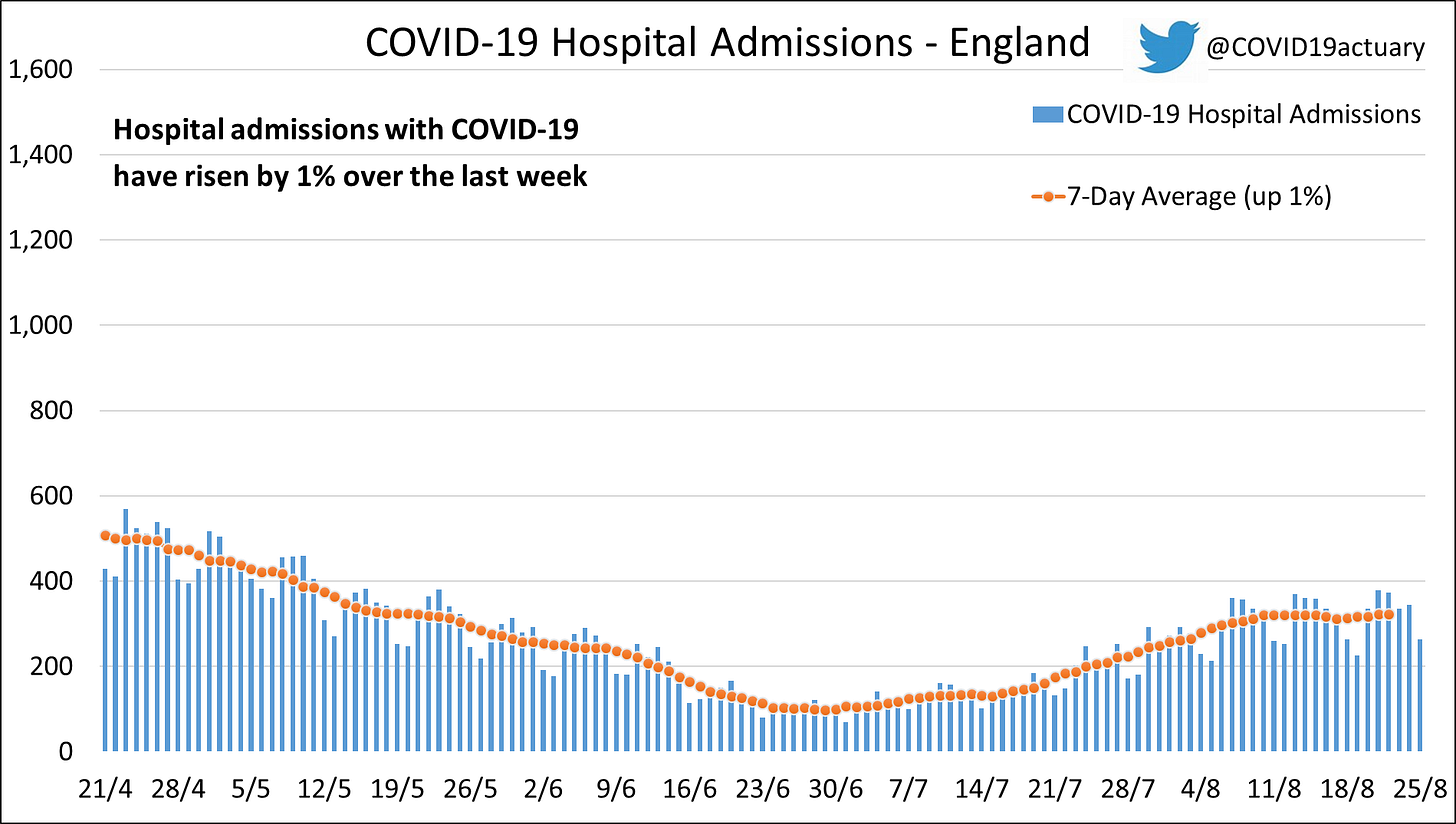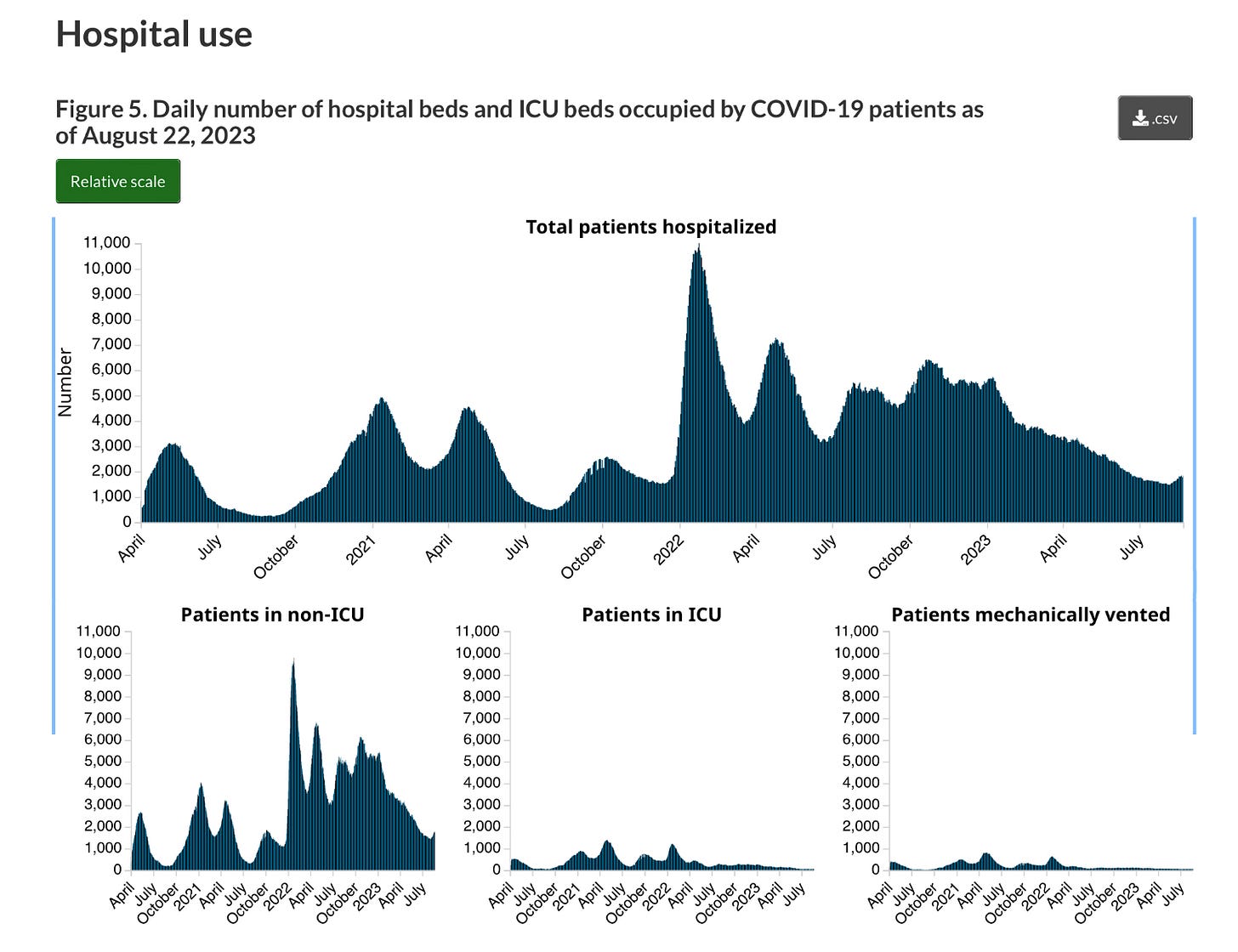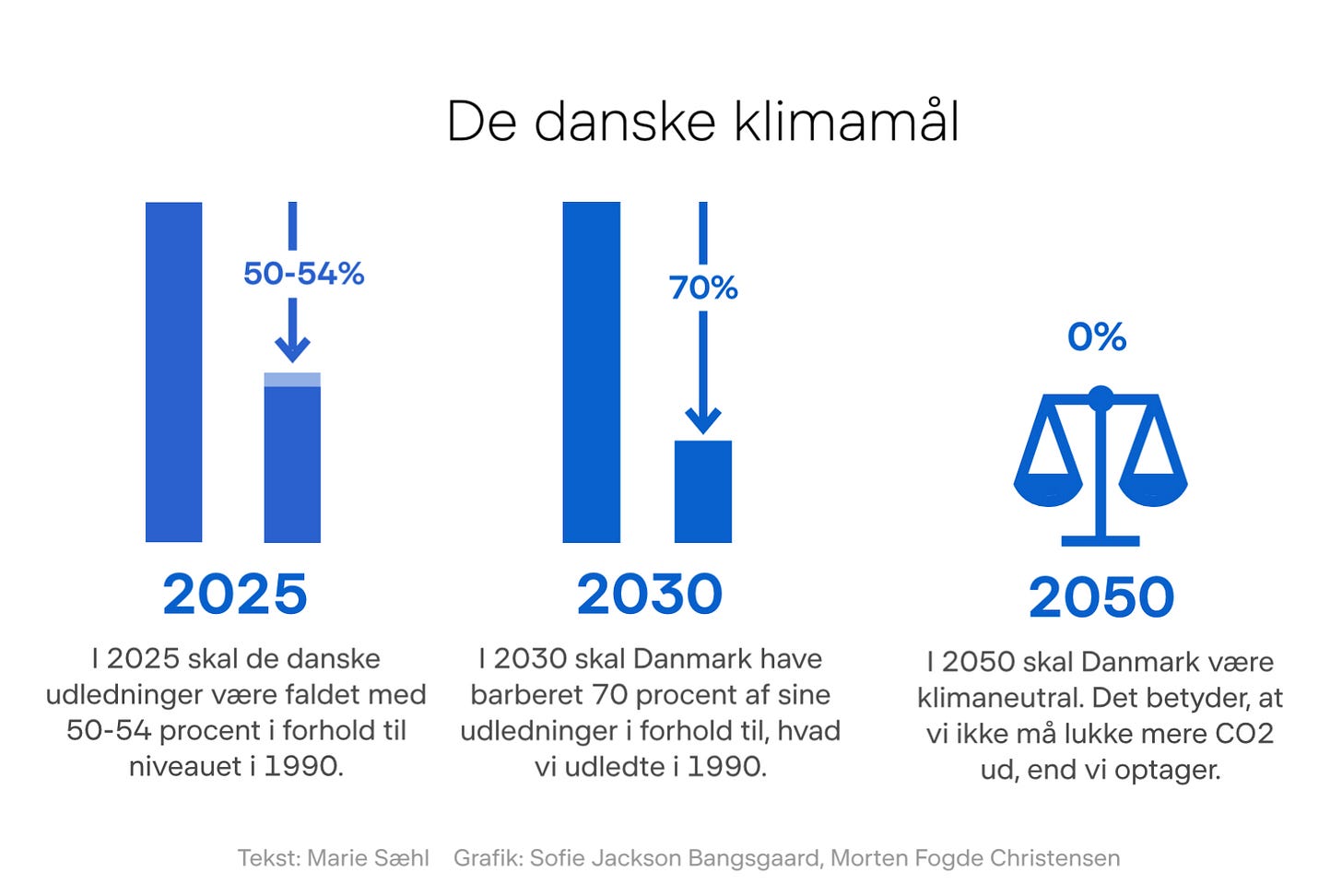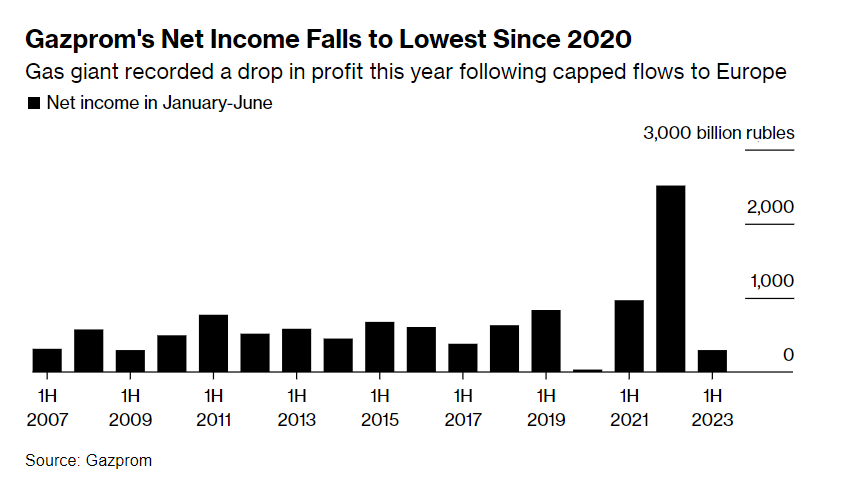🦠COVID🦠
🇩🇰
More BA.2.86 infections have been confirmed in Denmark. The Statens Serum Institute said six more infections confirmed to be the new strain have been identified in the latest batch of 185 sequenced positive test results. The SSI adds that “epidemiological and clinical data are being investigated.”
Denmark has the most confirmed cases of the new variant.
-
The Statens Serum Institute says infection numbers have been climbing for the last three or four weeks. The institute says it is seeing increasing numbers of coronavirus cases, a rising positivity percentage, and new infection-related hospital admissions. But it adds that data from the past week might indicate the infection is slowing.
The SSI says that the EG.5 sub-variant is now dominant across Denmark. As for BA.2.86, it says the new variant is circulating “but at a low level.”
-
The latest COVID wastewater surveillance data shows that coronavirus activity continues to increase in Denmark. But while the last three weeks have seen a “strong increase” in virus activity the Statens Serum Institute says the numbers also are beginning to indicate “slowing growth.”
-
While another round of COVID vaccine booster doses and influenza vaccinations will be available for those eligible in Denmark this fall the jury is still out on a new vaccine against the RS Virus.
The European Union approved the use of a new vaccine against RSV infections this week. But the Danish Health Authority says it is still “too early to say” if the new vaccine will be included in the Danish vaccination program. The authority says it is looking closely at the RSV vaccine.
RS virus infections have come storming back after all but disappearing during the first two years of the COVID pandemic. Last winter, many countries, including Denmark, suffered three infection waves from COVID, influenza, and RSV almost simultaneously.
-
Treatment for long-COVID continues to evolve in Denmark. The Danish Health Authority has revised its long-COVID recommendations this week. This is the fourth revision so far. The changes are aimed at healthcare professionals who are treating people suffering from ongoing COVID symptoms long after they were supposed to have ‘recovered’ from their initial infection.
The health authority notes in this latest update that the treatment of long-COVID patients has “gradually become an integral part of the healthcare system.”
Section Leader Line Riddersholm says the biggest lesson so far have been that treating long-COVID requires multidisciplinary treatment.
"When the recommendations were drawn up for the first time, the COVID pandemic was at its peak, and therefore for the most part our focus was on ensuring that there were treatment options for long-COVID patients. Today, we are a place where interdisciplinary services have been set up for people with long-term and complex symptoms of long-COVID, and where the healthcare staff has gained more experience in investigating and treating patients.”
The agency says that they are now diagnosing fewer and fewer cases of long-COVID.
🦠
Mixed news on the BA.2.86 variant from Peking University’s CAO Lab. They found that the new variant is much better at slipping around immune protections, which is bad news. But the laboratory team also found that it has much lower cell infectivity properties, meaning it isn’t super infectious, which is good news. The third significant finding is that the new variant is totally distinct from the XBB.1.5 strain, which is bad news because the new COVID booster doses target the XBB.1.5 variant.
“In sum, we found that BA.2.86 is antigenically distinct from XBB.1.5 and can escape XBB-induced neutralizing antibodies. The updated vaccine's efficacy against BA.2.86 should be closely monitored; however, BA.2.86 may not prevail very fast due to its lower infectivity.”
This is just one scientific peek at the new variant but more data from laboratories like this will soon begin to arrive and help answer some crucial questions.
🇸🇪
The BA.2.86 COVID variant has landed in Sweden. As of Thursday, the Swedish Public Health Agency has submitted four sequenced positive test results to GISAID, the global virus genome database.
Worth noting that the Swedish Public Health Agency hasn’t released any information on the presence of the new variant in Sweden, other than uploading the genome sequencing to GISAID.
-
COVID hospitalizations in #Sweden (212) continue to rise (+61) while the number of severely infected people requiring intensive care (5) also increased (+4).
🇪🇺🦠
Infection indicators are rising across Europe. In its latest weekly snapshot, the European Centre for Disease Prevention and Control says coronavirus transmission is increasing in more than half of the countries reporting data.
One of the biggest signs of increased infection activity is the positivity percentage, which increased across 13 countries (Croatia, the Czech Republic, Estonia, Greece, Hungary, Ireland, Latvia, Liechtenstein, the Netherlands, Poland, Romania, Slovenia, and Sweden). Infection numbers are rising across all age groups in five countries (Croatia, Greece, Ireland, Luxembourg, and Romania). While five others are seeing cases rise but just among vulnerable seniors over 65 (Finland, Iceland, Liechtenstein, Norway, and Sweden).
The ECDC says the overall number of hospitalizations for respiratory infections remains low compared to what is usually seen in the winter. Numbers are also in line with what we saw in Europe over the same time period last year.
Greece is the only country to report an increase in coronavirus-related hospitalizations. It was also the only country in Europe to see an increase in COVID deaths. Across the 15 countries reporting fatality numbers there were 52 more lives lost to the virus in week 33.
Just 11 countries met the ridiculously low threshold of submitting at least 10 sequenced positive test results over a two-week period. Of those, it appears XBB.1.5 is dominant. The fact that neither the EG.5 nor BA.2.86 variants are even mentioned, even though we know both are active in Europe, gives you an idea of how little we know now about variant activity across the EU.
Six countries including some of the biggest in Europe (Austria, Cypress, France, Germany, Portugal, and Spain) did not report any COVID data at all. Others like Denmark, Belgium, and Slovakia only reported the number of tests administered and nothing else.
“Current data availability makes it challenging to assess the COVID epidemiological situation in the EU/EEA. Although some countries have continued with primary care syndromic surveillance this summer, the low levels of testing of symptomatic patients in these settings add substantial uncertainty to estimates of SARS-CoV-2 positivity.”
🇪🇺💉
The European Medicines Agency has recommended that the newly formulated variant-specific vaccine from Pfizer/BioNTech be allowed to be used in Europe. The bivalent vaccine targets the XBB.1.5 variant. The European Commission must render a decision something it usually does in short order following an EMA recommendation.
Once officially approved the newly formulated vaccine will be used across Europe in fall booster dose campaigns.
🌍 🦠
Global COVID numbers continue to rocket back upward according to the latest weekly assessment from the World Health Organization. The global health agency is stressing that it is getting more and more challenging to determine the true infection picture.
“As countries discontinue COVID-specific reporting and integrate respiratory disease surveillance, WHO will use all available sources to continue monitoring the COVID epidemiological situation, especially data on impact. COVID remains a major threat and WHO urges Member States to maintain, not dismantle, their established COVID infrastructure. It is crucial to sustain early warning, surveillance, and reporting, variant tracking, early clinical care provision, administration of vaccine boosters to high-risk groups, improvements in ventilation, and regular communication.”
The WHO says this is the last weekly COVID update. It will now issue its global infection assessment once a month.
In the latest 28-day reporting period ending August 20, the WHO says there were almost 1.5 million new infections reported (+63%) and over 2,000 more lives were lost to the virus (-48%). Keep in mind infection numbers are likely very underreported.
With over 1.2 million new infections (+117%) South Korea continues to see by far the highest number of coronavirus cases of any country on earth. It also recorded 398 more COVID deaths (+100%). Other COVID hot spots include the UK with over 21,000 new cases (+92%), Italy recorded almost 20,000 new infections (+32%), Belgium (+175%), Ireland (+174%), the Czech Republic (+146%), Kuwait (+89%), Iran (+55%), Nepal (+217%), and India (+2%).
Infection-related hospitalizations increased around the globe, or at least among the 27 countries still reporting hospital data to the WHO. Of those, there were 49,380 new admissions (+21%). Just 22 countries submitted intensive care data. Of those, there were 646 new ICU patients (-44%).
Eight countries saw hospital admissions rise by over 20%. They are Bangladesh (+321%), Ireland (+139%), Greece (+103%), Kyrgyzstan (+67%), the United States (+52%), Malta (+51%), Mexico (+24%), and the Netherlands (+23%). Of those, the United States had the highest overall number of new admissions with 37,721.
Just six countries recorded a significant increase in severely infected patients requiring intensive care. They are Ireland (+167%), Malta (+75%), Singapore (+67%), Latvia (+67%), Greece (+59%), and the Netherlands (+20%).
-
The number of sequenced positive test results being submitted to GISAID continues to drop like a rock at the same time the World Health Organization is urging for those numbers to go up, not down. In the latest 28-day reporting period just 11,310 sequenced test results were shared with the international genome database. That is down sharply from the 34,064 sequenced tests submitted in the previous 28-day period.
The WHO says the impacts of the mutations in the BA.2.86 variant remain unknown. It says increased testing and genome sequencing will help shed some much-needed light on this new strain.
The global health agency says new data shows the EG.5 variant has similar immune escape abilities as XBB.1.5, the formerly dominant strain now in decline.
The WHO says in the last five weeks only two variants, BA.2.86 and XBB.1.9.1 have shown increasing growth.
🇬🇧
With new, and possibly more concerning, COVID variants popping out of the woodwork the United Kingdom is moving up its booster dose campaign. Newly formulated variant-specific COVID boosters, alongside influenza vaccinations, will now be available by September 11. The UK Health Security Agency says they have moved up vaccination efforts by a month as a precautionary measure due to the arrival of new coronavirus strains, especially the BA.2.86 variant.
“According to the latest risk assessment by UKHSA, BA.2.86 has a high number of mutations and has appeared in several countries in individuals without travel history. While BA.2.86 is not currently classified as a variant of concern, advice from UKHSA suggests that speeding up the autumn vaccine programme will deliver greater protection, supporting those at greatest risk of severe illness and reducing the potential impact on the NHS.”
Vulnerable seniors in care, seniors care staff, all seniors over 65, healthcare staff, and other high-risk groups will get the first crack at getting boosted. The UKHSA says other eligible groups will be invited next.
The agency says it will announce all the details of its sped-up fall vaccination campaign soon.
Health Minister Maria Caulfield:
“As our world-leading scientists gather more information on the BA.2.86 variant, it makes sense to bring forward the vaccination programme. It is absolutely vital the most vulnerable groups receive a vaccine to strengthen their immunity over winter to protect themselves and reduce pressure on the NHS. I encourage anyone invited for a vaccination, including those yet to have their first jab, to come forward as soon as possible.”
Just a reminder that at the moment we still have limited information about the BA.2.86 variant other than it has made an evolutionary jump not seen since Omicron arrived in the fall of 2021.
-
COVID hospitalizations edged upward slightly (+1%) in England according to the COVID Actuaries Response Group. Infection-related admissions declined in London and several other regions but increased in the country’s Northeast and severe other areas. Intensive care occupancy also crept up (+1%).
The reinfection rate, or R0, is estimated at 1.00, down slightly from last week. Anything over 1 indicates degrees of a spreading epidemic.
🇨🇦
The BA.2.86 variant has arrived in Canada. A single confirmed infection was identified earlier this week in British Columbia.
-
The Public Health Agency of Canada says COVID activity is increasing albeit from low levels. The positivity percentage has increased for a sixth straight week and is now 11.6%. The agency also cites an increasing number of coronavirus outbreaks being reported after a “period of stability.”
On the variant front PHAC says XBB.1.16 is no longer the dominant strain in Canada as the EG.5 and its sub-variants have now taken over.
COVID hospitalizations continue to climb across Canada. In the week ending August 23, the total number of beds in use by an infected patient rose by 173 to 1,836 beds in use. General admissions continued to see the bulk of those increases (+105). But intensive care numbers also continued to creep upward increasing by eight to 60. Only the number of severely infected people requiring a ventilator bucked the trend with 53 people still being mechanically vented, two fewer than the week before.
🇨🇳 🦠
Two recent studies have estimated that the massive infection wave that engulfed China after it suddenly abandoned its strict zero-COVID policy resulted in a shocking number of lives lost. One study, published in JAMA Network Open, estimated there were 1.87 million excess deaths in the two months after the zero-COVID approach was scrapped. Another study estimated that there were 1.41 million COVID deaths in China in the 35 days after restrictions were lifted.
Due to China’s strict zero-COVID approach, it didn’t have the population-level immunity acquired by other countries that were more exposed to infection waves. Also, vaccination rates in China, especially among vulnerable seniors, were extremely low. Researchers determined that when restrictions were suddenly lifted in December of last year COVID swept through roughly 90% of China’s population in the following month.
“The decision to relax China's zero-COVID policies without adequate measures to protect high-risk populations had severe consequences. Other countries prioritized vaccines for older age groups and other vulnerable populations, and many studies have indicated that targeting medical countermeasures and protective measures toward groups with high infection-fatality rates can be life and cost-saving.”
The study says that China’s official reports vastly underestimated the COVID death toll.
You can find the studies HERE and HERE.
🍃Environment & Energy⚡️
🇩🇰
Increasing the diesel tax is being discussed among Danish parliamentarians as negotiations continue to chart a path for Denmark to achieve its CO2 reduction goals. Leader of the Moderates Party, and Denmark’s Foreign Affairs Minister, Lars Løkke Rasmussen says increasing the diesel tax is unavoidable if Denmark is to achieve its climate goals.
Rasmussen spoke to DR after a party meeting:
“We want to be the guarantor that we achieve the 2025 goals in an evidence-based way, where there is no professional doubt that the goals will be achieved. If you have that ambition, you can't avoid looking at the transport sector, and you can't avoid discussing the diesel tax either.”
He stresses that this is the stance of his party and not an official position of the government. The Moderates are one of the three major parties currently forming the governing coalition.
If adopted any tax increase on diesel will likely be targeted at big commercial vehicles and the transportation industry.
Denmark has pledged to reduce CO2 emissions between 50 to 54% by 2025, by 70% below 1990 levels by 2030, before becoming completely carbon neutral by 2050.
-
Danish wind energy giant Ørsted took a beating on the markets this week. Experts say this reflects major challenges facing the entire offshore wind industry. The company, which is half-owned by the state, saw its stock value drop by a full quarter in a single day this week. That wiped out about 58 billion Danish kroner (about $11.4 billion Cdn) of the company’s market value.
This week, Ørsted announced that due to a number of issues it is writing down the value of three of its U.S.-based wind turbine projects by five billion kroner. Further, it stated that another 11 billion in write-downs might be pending.
Sydbank Equity Analyst Jacob Pedersen spoke to DR:
“Ørsted's big write-down today comes from the fact that there are some things that cannot be delivered at the right times. They have some elements that need to be in the sea, which have not arrived on time because the whole supply chain cannot keep up with the growth that is there. Ørsted is absolutely the best and most skilled offshore wind developer, and when you make an announcement like this, it must send chills down the backs of all the others in the industry.”
Indeed after the Ørsted announcement a ripple effect in share prices was seen in competitor wind energy businesses Vestas and Siemens.
Pedersen says this is a big indicator of some serious problems facing the offshore wind industry right at the time Europe is leaning on it to transition away from fossil fuels.
“For some years there has been a crisis with the wind turbine manufacturers. There is no doubt that the changes that have taken place in the economy and the turbo growth that we are facing in the offshore wind market present some challenges now. With rising costs and a significantly higher level of interest, Ørsted can suddenly no longer make money on the projects that they have bid for and won.”
He says this not only poses major problems for the offshore wind industry but in the worst-case scenario it could also seriously slow down Europe’s green energy transition.
-
Passengers are returning to Denmark’s rail system. The National Danish rail company, DSB, says in its report on the first half of the year that both passenger numbers and its bottom line have increased. In the first six months of the year, 80.4 million passengers have used the train system, a 14% year-over-year increase. The company’s booms are well in the black with a profit of 375 million Danish kroner (about $73 million Cdn).
That said, travel delays due to maintenance work and work stoppages due to labour disputes have been a major inconvenience this year resulting in 190,000 lost journeys. In the first half of the year 72.9% of travelers have arrived within three minutes of their scheduled arrival time.
🇪🇺/ 🇷🇺
Losing its biggest customer is beginning to have an impact on Gazprom’s bottom line. Last year, Russia weaponized its oil and gas exports to Europe in a bid to bring the EU to its knees over its support of Ukraine. Since turning off the taps Europe has put rocket jets on its energy transition as it turns its back on Russian energy supplies. In the first half of this year Russia’s state-owned energy agency, Gazprom has seen its net income drop like a rock as exports to Europe plummeted. Its net income fell to 296.2 billion rubles (about $3 billion USD). That is down from 2.5 trillion rubles (about $26 billion USD) in the same period last year.
But while Europe closes its doors to Russian energy Gazprom is reporting increasing energy exports to China.
🇪🇺
A first look at inflation in Europe this month seems to indicate that things are treading water from month to month. According to the EU statistics agency EuroStat inflation in the Euro area was 5.3% in August. That is in line with inflation in July. Food, alcohol, and tobacco products increased (+9.8%), as did services (+5.5%), but energy went the opposite direction (-3.3%).
🇫🇮
Inflation is slowly easing in Finland but food prices are still extremely high. According to the Finnish Grocery Trade Association, the price of food and non-alcoholic drinks rose by an average of 8.2% in July compared to the same month the year before. The association says prices were up 12.8% from Ja Harry to June of this year. But while still very high the group notes the price increases have been slowing for four straight months now.
🇺🇦/ 🇷🇺 War
🇩🇰 🇬🇷 🇨🇿
Greece and the Czech Republic have joined the F-16 coalition. That makes 13 countries working together to train Ukrainian pilots and technicians on how to fly and maintain F-16 fighter jets.
Denmark’s Minister of Defense Troels Lund Poulsen says it hasn’t yet been determined what the two new countries joining the coalition will contribute.
“We will talk to them about that. We hold meetings at the official level in the coalition on an almost weekly basis. Now there is broad support from 13 countries, led by Denmark and the Netherlands. I think when we get into the month of September, we will see more joining.”
Denmark has already begun its program to train Ukrainian pilots to fly the F-16. Denmark along with the Netherlands and Norway are also the only three countries to donate F-16 fighter jets to Ukraine.
“I expect in the fall that several countries will say that they will donate aircraft. How many planes and which countries? It is probably too early to say. But I am convinced that it will not just be the three countries that have so far said that they will donate aircraft.”
🇷🇴 🇳🇱 🇺🇦
Romania and the Netherlands have signed a deal with Lockheed Martin to get Ukrainian pilots trained on flying F-16 fighter jets. According to the agreement Romania will host the actual fighter jet training program, the Netherlands will supply the F-16 aircraft, and Lockheed Martin will provide the actual training as well as the maintenance of the jets.
🇵🇱 🇺🇦
With Ukrainian pilots being trained to fly more modern F-16 fighter jets and an influx of donated jets pending, a Polish company is responding to the demand. Poland’s largest aerospace manufacturer PZL Mielec, a Lockheed Martin subsidiary, has begun production of the F-16’s main fuselage.
President and General Director Janusz Zakręcki said this marks a return to the company’s roots.
“The production of F-16 Block 70/72 structures at PZL is located in a comprehensively modernized hall. That's 14,000 square meters of space. In the past, military jet aircraft were produced here. I am glad that Lockheed Martin appreciated the competence of our employees and the potential of this place and decided to locate the F-16 structures production here.”
🇩🇪 🇺🇦
Germany is sending another weapons package to Ukraine. This latest shipment will include ten more Leopard 1 A5 battle tanks, a TArML-4D air surveillance radar, more VECTOR reconnaissance drones, over ten million rounds of ammunition, a field hospital, and more commercial trucks and trailers to help with logistics.
🇸🇪/ 🇷🇺
A man is facing charges of spying for Russia. The man is suspected of attempting to gather intelligence involving defense technologies from both Sweden and the United States. He was formally charged earlier this week and has pleaded not guilty.




